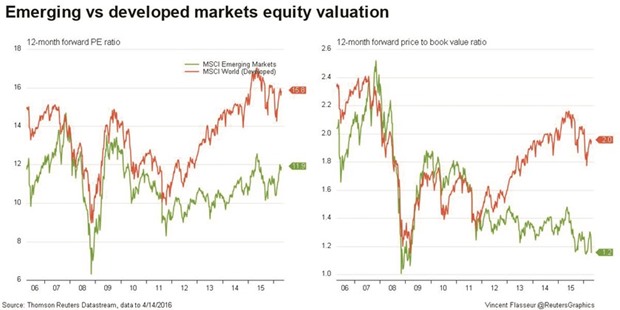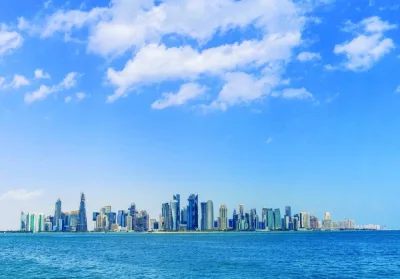Three months into an emerging market rally, investors are still waiting for the uptick in growth and exports needed to keep the rebound from fizzling out.
So far, the rally has been about investment funds re-positioning after long avoiding what are markets with a track record for volatility. Now they are closing their eyes to a dour economic picture and betting long-term valuations are cheap enough to warrant some exposure.
But after a horrific 2015 and a new year meltdown transformed into double-digit returns for bonds year-to-date and an 8% gain for emerging equities, evidence of economic recovery remains the missing link.
Bank of America Merrill Lynch is the latest to turn positive, advising clients on Tuesday to “get off the fence” and buy emerging equities.
The big question is whether this can last.
Some reckon not, arguing gains are driven primarily by US Federal Reserve backpedalling on interest rates, giving temporary relief to developing economies by deflating the dollar and spurring a commodity price recovery.
Yet stubbornly weak growth in the developing world will hobble emerging equity markets in time, they argue.
The International Monetary Fund recently cut 2016 growth forecasts for developing countries to 4.1%. But for the 19 biggest emerging economies, the average growth rate is worse, standing 1.6% above that of developed peers, the narrowest gap in 16 years, according to UBS research.
In 2009, this premium was 7.5%, UBS says, noting strong correlation between the growth gap and capital flows to emerging markets.
What’s more, investors have seen this kind of bear market rally before. Morgan Stanley identifies this as the ninth “counter-trend” rally since emerging equities turned negative in late 2010.
“Pretty much every year you get a fairly significant rally in emerging markets. It happened from the start of 2014, and from March 2015 ... The trough-to-peak rally in 2014 was 22.5%, and so far this year we have had about 22.5%,” said Will Ballard, a fund manager at Aviva Investors.
But there are some positive signs in subsets of the emerging universe. With a basket of countries tracked by the Institute of International Finance, March growth quickened to an eight-month high of 3.3%. The picture on trade, emerging markets’ lifeblood, may also finally be improving - or at least deteriorating at a slower pace. Emerging exports declined 7.2% year-on-year in dollar terms in February, the smallest fall in 12 months, Capital Economics estimated.
And although Chinese first quarter economic growth came in at its slowest since 2009 at 6.7 pct, loans, retail sales and industrial output were better than forecast.
“This year’s rally is because of things that didn’t happen. The Chinese economy didn’t fall off a cliff and there hasn’t been an emerging market crisis as people expected,” said William Jackson at Capital Economics.
In the words of UBS analysts, emerging economic data still “fails to back sentiment”, above all on trade. The ratio of global trade growth in volume terms versus economic output averages 1.07 these days, versus 1.6 in the mid-2000s and 2.2 in the 1990s. Slower Chinese and Western demand are to blame.
In dollars, emerging exports are declining by 10% annually, they calculate.
“We see this change as structural, and have consistently argued that emerging assets are wrongly assessed as being cheap because this change is not being incorporated into fair value models,” UBS said.
It’s mainly the historically low valuations after five years of underperformance that have been luring investors – MSCI’s emerging equity index trades at a roughly 25% discount to developed peers.
But discounts are narrowing. Brazilian stocks’ 33% rally this year leaves them trading at 12 times forward earnings, well above historical averages despite messy domestic politics and an economy shrinking up to 4% this year. “If you look at the underlying state of the economy, it’s in absolutely terrible shape. You’ve seen multiple expansion but there’s no sign that earnings will support that higher multiple,” Aviva’s Ballard said.
Emerging earnings overall are headed for a fifth year in recession, Morgan Stanley says, predicting a 7% drop in 2016.
Still, the sector increasingly has fans.
Devan Kaloo, head of emerging equities at Aberdeen Asset Management, says that while EM earnings slipped 3% last year in dollar terms, they grew 10% in local currency once resource companies are stripped out.
And BAML argues that 40% of emerging currencies are at their most competitive levels ever in trade-weighted terms and this should presage at least some export and trade benefits.

..


